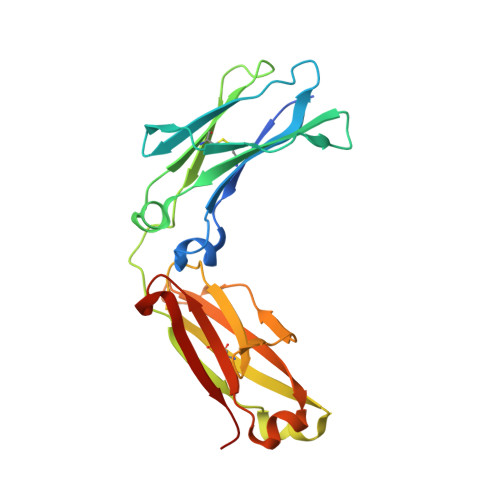Engineered Fc-glycosylation switch to eliminate antibody effector function.
Zhou, Q., Jaworski, J., Zhou, Y., Valente, D., Cotton, J., Honey, D., Boudanova, E., Beninga, J., Rao, E., Wei, R., Mauriac, C., Pan, C., Park, A., Qiu, H.(2020) MAbs 12: 1814583-1814583
- PubMed: 32892677
- DOI: https://doi.org/10.1080/19420862.2020.1814583
- Primary Citation of Related Structures:
6X3I - PubMed Abstract:
Antibodies mediate effector functions through Fcγ receptor (FcγR) interactions and complement activation, causing cytokine release, degranulation, phagocytosis, and cell death. They are often undesired for development of therapeutic antibodies where only antigen binding or neutralization would be ideal. Effector elimination has been successful with extensive mutagenesis, but these approaches can potentially lead to manufacturability and immunogenicity issues. By switching the native glycosylation site from position 297 to 298, we created alternative antibody glycosylation variants in the receptor interaction interface as a novel strategy to eliminate the effector functions. The engineered glycosylation site at Asn298 was confirmed by SDS-PAGE, mass spectrometry, and X-ray crystallography (PDB code 6X3I). The lead NNAS mutant (S298N/T299A/Y300S) shows no detectable binding to mouse or human FcγRs by surface plasmon resonance analyses. The effector functions of the mutant are completely eliminated when measured in antibody-dependent cell-meditated cytotoxicity (ADCC) and complement-dependent cytotoxicity (CDC) assays. In vivo , the NNAS mutant made on an antibody against a human lymphocyte antigen does not deplete T cells or B cells in transgenic mice, in contrast to wild-type antibody. Structural study confirms the successful glycosylation switch to the engineered Asn298 site. The engineered glycosylation would clash with approaching FcγRs based on reported Fc-FcγR co-crystal structures. In addition, the NNAS mutants of multiple antibodies retain binding to antigens and neonatal Fc receptor, exhibit comparable purification yields and thermal stability, and display normal circulation half-life in mice and non-human primate. Our work provides a novel approach for generating therapeutic antibodies devoid of any ADCC and CDC activities with potentially lower immunogenicity.
Organizational Affiliation:
Biologics Research, Sanofi , Framingham, MA, USA.
















